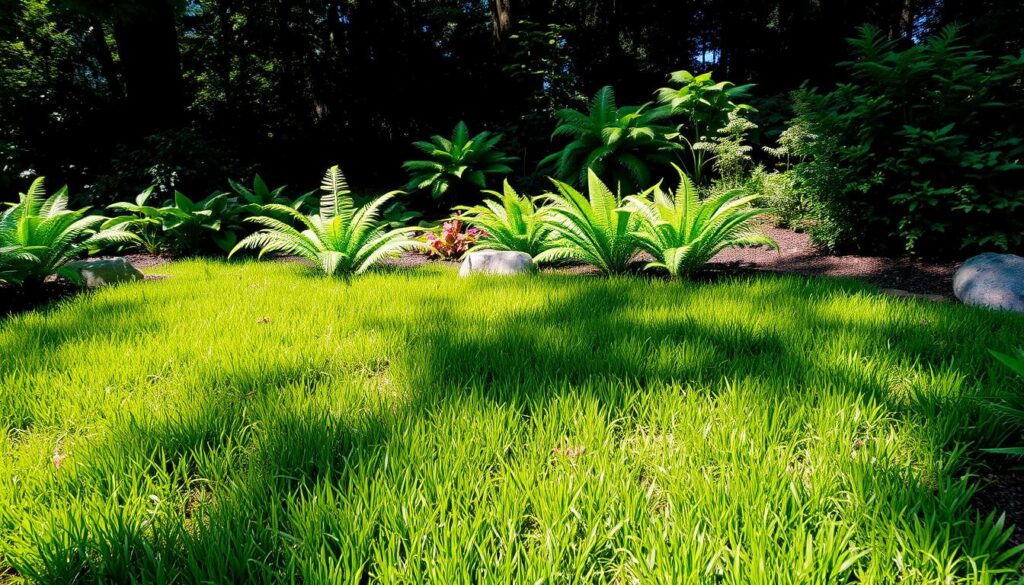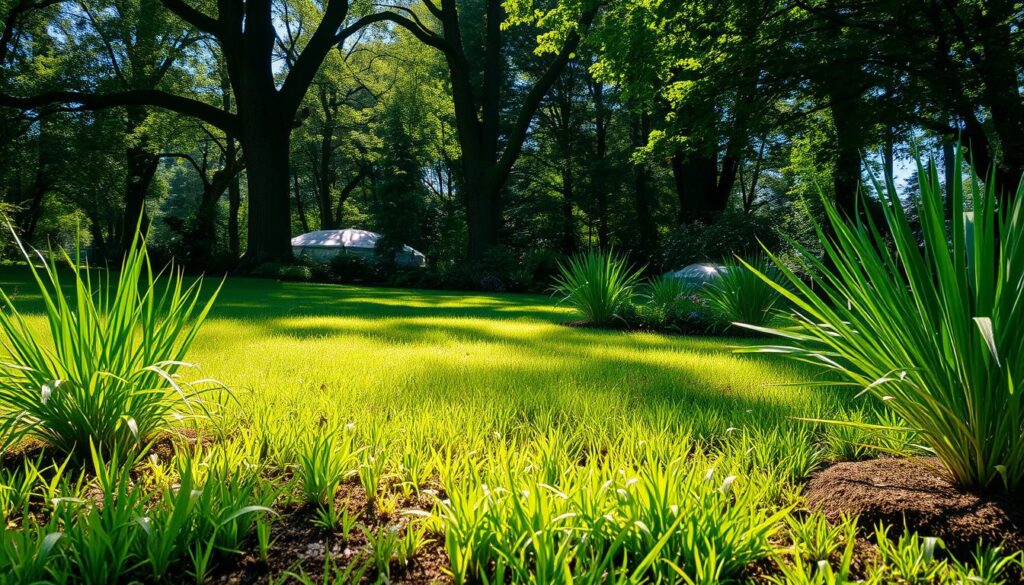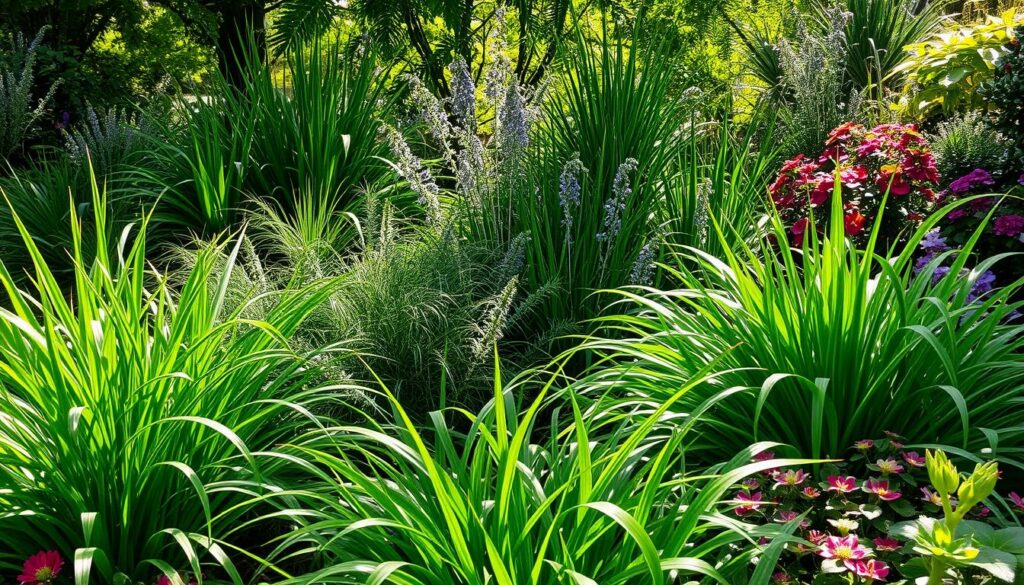Many homeowners face challenges growing grass in shaded spots. They wonder if it’s possible to grow a lawn without sunlight. The answer is yes, with the right shade solutions, you can have a beautiful lawn.
Growing grass in the shade is different from regular lawn care. It needs grass types that can handle low light. These grasses are special and can thrive in shaded areas.

Knowing the challenges of growing grass in the shade is key. By picking the right grass and using important care tips, you can have a lush lawn. Even in spots with little sunlight, your lawn can look vibrant and healthy.
Key Takeaways
- Growing grass in the shade requires shade-tolerant grass varieties
- Lawn care in shade needs a different approach than traditional lawn care
- Shade solutions can help achieve a beautiful and healthy lawn
- Understanding the challenges of growing grass without sunlight is important
- Essential maintenance techniques are necessary for a lush and vibrant lawn
- Can you grow a lawn without sunlight? Yes, with the right techniques and knowledge
Understanding the Challenges of Growing Grass Without Sunlight
Grass needs sunlight to grow well. Without it, lawns can face problems like thin grass, weeds, and compacted soil. Knowing these challenges and the shade type is key to fixing these issues.
It’s important to know the shade type to care for your lawn right. There’s partial, full, and dappled shade. Each needs its own care to keep the grass healthy and green.
- Thinning grass: Grass may become sparse and weak due to lack of sunlight.
- Weed growth: Weeds can thrive in shaded areas, competing with grass for water and nutrients.
- Soil compaction: Shaded areas can be prone to soil compaction, which can prevent proper drainage and aeration.
Understanding sunlight’s role and your lawn’s shade type helps. You can then find the best ways to care for your lawn in the shade.
| Shade Type | Characteristics | Maintenance Techniques |
|---|---|---|
| Partial Shade | 4-6 hours of direct sunlight | Regular watering, fertilization, and mowing |
| Full Shade | Less than 4 hours of direct sunlight | Infrequent watering, minimal fertilization, and occasional mowing |
| Dappled Shade | Intermittent sunlight filtering through trees | Variable maintenance techniques depending on the intensity of sunlight |
Can You Grow a Lawn Without Sunlight? Exploring Shade Solutions
Sunlight is key for grass to grow, but you can have a lawn without it. Shade solutions help you grow a healthy lawn, even in the shade. Choosing the right plants and care is important.
For shady spots, use plants that love the shade. These plants make your lawn look lush and green. Yes, you can grow a lawn without sunlight with the right plants and care.

For a lawn in the shade, pick grass that does well in the shade. Adjust when you mow and water. Adding organic matter to the soil also helps.
Looking into shade solutions means considering moss or clover as ground covers. They do well in the shade and can make your lawn unique and beautiful.
Best Shade-Tolerant Grass Varieties for Low-Light Areas
Choosing the right grass for shady spots is key to a lush lawn. Shade-tolerant grasses do well in low light. Cool-season grasses are a top pick because they handle partial shade and need less care.
Perennial ryegrass, fine fescue, and tall fescue are great for shady spots. They handle some sun but shine in the shade. For full sun to partial shade, zoysia grass and buffalo grass are better.

Cool-Season Grasses for Shade
- Perennial ryegrass: a dark green grass with a fine texture
- Fine fescue: a low-maintenance grass with a delicate texture
- Tall fescue: a durable grass with a coarse texture
Warm-Season Options for Shaded Lawns
Warm-season grasses also do well in the shade. Zoysia grass and buffalo grass are perfect for areas with some sun. They need less water and care than cool-season grasses.
Essential Maintenance Techniques for Shaded Lawns
Shaded lawns need special care to thrive. You must adjust your mowing, watering, and fertilizing routine. For example, mowing should be done at a higher height to let more sunlight in. Also, watering should be less frequent but deeper to help the roots grow strong.
To keep your shaded lawn healthy, consider these tips:
- Use a sharp mower blade to prevent tearing the grass
- Fertilize your lawn with a balanced fertilizer during the growing season
- Prune trees and shrubs to allow more sunlight to reach the lawn
Maintaining a shaded lawn can be tough, but the right techniques can help. By following these tips and adjusting your lawn care, you can have a beautiful lawn, even in low-light areas.
Soil Preparation and Management in Low-Light Conditions
Getting your soil right is key to a healthy lawn in shaded spots. You need the right soil pH, good drainage, and the right food for your grass. Soil prep is the base of a strong lawn, as it affects how well your grass gets nutrients.
Soil management means keeping the pH just right for your grass. Most grass likes a slightly acidic to neutral soil pH, between 6.0 and 7.0. Also, you need to make sure water drains well to avoid root rot. Your fertilization plan should match your grass’s needs, considering soil type, climate, and how you’ll use the lawn.
Some important things to think about for soil prep and management in low-light areas include:
- Keeping the soil pH just right with regular checks and tweaks
- Using good drainage methods, like French drains or permeable pavers
- Creating a fertilization plan that’s good for the environment and your grass
By focusing on soil prep and management, you can have a great lawn even in tough low-light spots. It’s all about the right soil pH, good drainage, and the right fertilization. These things together help your grass grow strong and healthy.
| Soil Preparation Aspect | Importance | Recommended Approach |
|---|---|---|
| Optimal Soil pH | High | Regular testing and adjustments |
| Drainage Solutions | High | French drains or permeable pavers |
| Fertilization Strategies | Medium | Balanced nutrient input and environmental concerns |
Alternative Ground Covers for Heavy Shade
Growing grass in heavy shade can be tough. But, alternative ground covers offer a great solution. Plants like hostas, ferns, and astilbe love the dark and do well.
Here are some top lawn alternatives for shady spots:
- Moss: It’s soft, dense, and easy to care for.
- Clover: It fixes nitrogen and keeps weeds away.
- Creeping Thyme: It smells great and spreads out nicely.
When picking an alternative ground cover, think about your climate, soil, and how much work you want to do. The right shade-loving plants or lawn alternatives can make your shaded area beautiful and alive.
Looking into these options can help you find the best alternative ground cover for your space. You’ll create a beautiful outdoor area.
Conclusion: Creating Your Thriving Shade-Friendly Lawn
Growing a thriving shade-friendly lawn is possible with the right steps. First, understand the challenges of low light. Then, choose grass that does well in shade. Use special care techniques to make your shaded area lush and green.
Don’t forget about soil, drainage, and fertilization. These are key to a successful shaded lawn. With these tips, you can turn your shaded area into a beautiful oasis.
Now you know how to make a shade-friendly lawn that will thrive. Even with little sunlight, you can have a healthy, green lawn. Enjoy the beauty and benefits it adds to your property.
FAQ
Can you grow a lawn without sunlight?
Yes, you can grow a lawn without direct sunlight. Choose the right shade-tolerant grass. Prepare the soil well and follow key maintenance steps. This way, you can have a healthy lawn even in low-light areas.
What are the best shade-tolerant grass varieties for low-light areas?
For low-light areas, consider these grass types: – Cool-season grasses like Fine fescue, Tall fescue, and Shade-tolerant Kentucky bluegrass – Warm-season grasses such as Zoysiagrass and Centipedegrass – Mix different shade-tolerant grasses for a unique lawn
What are the essential maintenance techniques for shaded lawns?
To care for shaded lawns, follow these steps: – Mow at a higher height to capture more light – Water deeply but less often to promote deep roots – Use a balanced, slow-release fertilizer for nutrients – Prune trees and shrubs to let more light in
How do I prepare and manage the soil for a shaded lawn?
For a healthy shaded lawn, focus on soil care. Keep the soil pH between 6.0 and 7.0. Improve drainage to avoid waterlogging. Use a slow-release fertilizer or apply it more often for shaded lawns.
What are some alternative ground covers for heavily shaded areas?
For heavily shaded areas, consider these ground covers: – Shade-loving plants like Hostas, Ferns, and Ajuga – Moss for a lush, low-light texture – Groundcovers like Vinca minor (Periwinkle) or Pachysandra that tolerate shade




